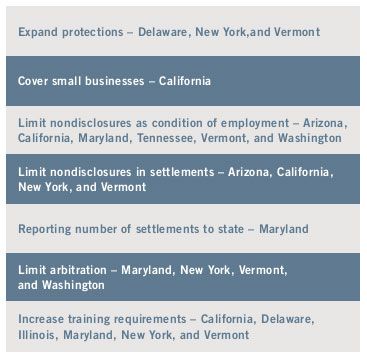With the midterm elections in the rearview mirror and an incoming Democratic majority in the House of Representatives, automotive industry employers can expect continued congressional gridlock on labor and employment issues. However, the Trump administration is poised to take significant regulatory action, and employers should anticipate focused immigration enforcement to continue. Meanwhile, there will likely be significant action at the state and local level, where Democrats will enjoy a newfound degree of control. These topics and more are covered below.
Federal Regulation in 2019
A controversial Obama-era National Labor Relations Board (NLRB) decision that expanded the definition of "joint employment" will likely be put to rest in 2019. (Under the "joint employment" test, an employer can be held responsible for labor law violations committed by a temporary staffing agency or secondary employer, for example, depending on various factors, including the control that the employer has over workers.) The NLRB issued a proposed rule to revert the definition of "joint employer" to its pre-2015 scope, which was much more deferential to employers. This change is welcome news for employers as it will reduce the risk of liability for labor law violations committed by other "joint" employers, such as contractors and franchisees.
Additionally, the Department of Labor (DOL) has announced plans to tackle overtime rules for salaried employees— including the minimum "salary threshold" required to qualify as exempt from overtime—by March 2019. Under the Obama administration, the DOL previously adopted regulations to increase the pay threshold for exempt salaried employees from $23,660 per year to $47,476 per year. That threshold would also have updated every three years to keep pace with inflation. The regulation was permanently blocked in federal court and was subsequently rescinded by the Trump administration, leaving the old rules and threshold in place. The new rule is expected to increase the salary threshold to around $33,000 per year.
The DOL has also hinted that it intends to address employee and independent contractor classifications in 2019. An Obama-era administrator's interpretation stated that most workers under most circumstances should be classified as employees rather than independent contractors. The Trump administration withdrew that guidance in 2017, and the DOL appears set to issue a new rule—likely one more lenient toward employers who use independent contractors—in mid-2019.
The Trump administration has also revived the DOL's dormant practice of issuing opinion letters. Opinion letters from the DOL respond to employer questions on a broad range of topics. Recent letters have discussed the compensability of travel time, the "reasonable relationship" between an employee's salary and actual earnings, and the payment of bonuses. The DOL is likely to continue issuing guidance in the form of these opinion letters, and they can be a valuable compliance resource for automotive industry employers.
Immigration Updates and Worksite Enforcement
In 2018, the Department of Homeland Security continued its efforts (1) to develop a "culture of compliance" with federal immigration law and (2) to promote hiring from the authorized workforce already within the United States pursuant to the Buy American, Hire American presidential executive order. DHS has done so primarily by increasing the scrutiny applied to immigration cases seeking permission to hire foreign nationals and by expanding worksite enforcement. This trend is likely to continue in 2019.
Higher Standards Applied in Employment-Based Immigration Cases – No Deference to Prior Decisions on Extension Requests and Increased Scrutiny: DHS, through United States Citizenship and Immigration Services (USCIS), is strictly applying the legal standards to various employment-based temporary classifications, such as H-1B specialty occupation and L-1 intracompany transfer. USCIS no longer gives deference to prior favorable decisions when the employer seeks an extension of the H-1B or L-1 employment authorization. Each request is considered anew. Further, under a new policy that began in September 2018, USCIS officers have more discretion on whether to move directly to a denial or to allow the employer another opportunity to submit evidence. It is likely that this policy will result in a higher rate of denials.
Increased FDNS Visits to Employers: USCIS also is increasing its site visits by Fraud Detection and National Security (FDNS) officers. The FDNS program has existed for several years, but it now is more robust. FDNS officers visit selected employers to confirm that such employers were truthful in their representations about the business, job, and foreign national. In most circumstances, these visits occur during the months after a favorable decision. The visits are most likely to occur in H-1B, H-2B, and L-1A cases.
Increased I-9 Inspections and Worksite Visits by ICE: In its year-end report, U.S. Immigration and Customs Enforcement (ICE) announced that it had quadrupled I-9 inspections in fiscal year 2018. ICE initiated 5,981 Form I-9 audits and opened 6,848 worksite investigations. ICE also assessed $10.2 million in civil penalties for I-9 violations and obtained orders for over $10 million more through judicial fines, forfeitures, and other sanctions. Employers should expect that ICE will continue to focus aggressively on I-9 compliance and inspections in 2019.
Prepare for an I-9 Inspection Now: Employers should take steps to prepare for government I-9 inspections and lower the risk of liability. Here are a few recommended actions:
- I-9 Forms for Current Employees: Confirm that the employer holds a valid Form I-9 for each current employee who was hired on or after November 7, 1986. There are strict timeframes for completing an I-9 Form, and doing so late is a violation. Nevertheless, a late I-9 is better for compliance than no I-9. Therefore, identify missing I-9 Forms for current employees hired on or after November 7, 1986, and promptly seek to complete an I-9 Form with such employees.
- I-9 Forms for Terminated Employees: Retain I-9 Forms for former employees for the longer of one full year after the employment ends or three full years from the date of hire. In an audit, the government will frequently ask for I-9 Forms for former employees covered by this retention period.
- I-9 Training: Ensure that only trained HR professionals or other trained staff handle the employer's I-9 compliance. It is very important that the employer's representative understands the I-9 rules in order to achieve compliance without violating the I-9 anti-discrimination prohibitions. Training should begin with reading the 15 pages of instructions that accompany Form I-9.
- Internal I-9 Audits: Once the employer's staff is trained, conduct periodic internal I-9 audits to review and correct, if necessary, the I-9 Forms. This is an important step to lowering the risk of liability in a government audit.
- Initial Response to Government I-9 Inspection: ICE usually will issue a Notice of Inspection (NOI) to commence a formal I-9 audit. ICE often mails the NOI, but sometimes will serve the NOI in person at the employer's premises. Employers have three business days to respond to the NOI. ICE may ask the employer if it wishes to waive the three-day period. It is almost never a good idea to do so. Instead, employers should use the time to prepare and consider contacting their attorneys promptly to discuss the response and strategy. If ICE has a warrant, it may take the I-9 Forms immediately, but most inspections begin with the NOI.
- Fines: I-9 violations can lead to civil fines and other sanctions. ICE will consider mitigating and aggravating factors to determine where within the civil fine range to impose such penalties against the employer. Employers may appeal the fines while attempting to negotiate a settlement with ICE. For the most egregious or for pattern and practice violations, criminal penalties may be imposed.
Possible Changes to H-1B Cap Allocation and Administration: In early December 2018, USCIS proposed changes in how it will apply the annual allocation of H-1B slots against new cases. The annual allocation is commonly called the "H-1B cap." More specifically, the H-1B specialty occupation is a classification under which American employers may seek temporary authorization to employ certain qualifying foreign nationals. For cases in which the foreign national has not previously been in H-1B status, the employer must prepare a well-documented case to petition USCIS for one of the H-1B cap slots. USCIS often receives many more cases than are allowed under the cap. Therefore, USCIS runs a random, computerized process to select the cases that the agency will consider. It rejects the rest.
Under USCIS's new proposal, employers will complete a short registration and submit it electronically. USCIS will run the random selection process against those registrations and notify the employers whose registrations are selected. USCIS then will grant such employers at least 60 days to prepare and submit their full cases on the merits. This change should put in place an orderly system with a reasonable schedule for cases that are selected to proceed. It will avoid the significant expenditure of the employer's resources on cases that are not selected. It also will save USCIS's time and resources by avoiding the current chaotic process in which USCIS often receives more than 200,000 H-1B cap subject cases over a few days and then spends months rejecting and returning most of those cases.
In addition, USCIS proposes a change to how it will administer the H-1B cap. There are a total of 85,000 H-1B cap slots: 65,000 slots under the regular H-1B pool (with 6,800 of those slots being allocated under the Free Trade Agreements with Chile and Singapore) and 20,000 slots under an advanced degree H-1B cap. For the advanced degree cap, only cases involving advanced degrees from American schools may be considered. In the past, USCIS first allocated the advanced degree cap and then allocated the regular cap. Cases involving advanced degrees were allowed to participate in both pools for possible selection. Under the new proposal, USCIS first will allocate the 65,000 regular cap slots and then allocate the 20,000 advanced degree cap slots. In this way, USCIS projects that 16 percent more of the cases selected under the cap will involve advanced degrees from American schools.
USCIS is accepting comments on this proposal until January 2, 2019. It is unclear whether USCIS will be able to review the comments and finalize its proposal before the April 2019 H-1B cap submission window. If not, look for this new procedure in 2020.
NAFTA's Replacement – USMCA: The North American Free Trade Agreement (NAFTA) has an employment provision under which American employers may seek authorization to employ qualified Canadian or Mexican citizens in professional occupations specifically named in the treaty. The Trump administration has stated numerous times that it will withdraw from NAFTA because of concerns over the trade provisions. Some American employers have been concerned that without NAFTA, they would lose the ability to employ their current Canadian or Mexican professionals.
On November 30, 2018, President Trump, the president of Mexico, and the prime minister of Canada signed a new treaty called the "USMCA." The USMCA retains the employment authorization provision for certain professional occupations that is found in NAFTA. The new treaty is not yet in effect. The Senate first must ratify the USMCA and then there will be a transition period. As of December 2018, NAFTA is still in place and should remain so until at least six months after President Trump formally withdraws the United States from that treaty.
Workplace Sexual Harassment
As the #MeToo movement enters its second year, enforcement agencies and policymakers are responding in earnest. In 2018, the Equal Employment Opportunity Commission (EEOC) filed 50 percent more sexual harassment lawsuits than in the previous year and recovered nearly $70 million for victims—an increase of $22.5 million over 2017.
States have also been active in addressing issues raised by the #MeToo movement. Lawmakers around the country passed a number of initiatives in 2018 to curb workplace sexual harassment. For example, some states expanded the scope of their laws to cover interns, apprentices, applicants, and independent contractors. Other states limited employer-employee arbitration in harassment cases and the use of nondisclosure agreements as a condition of employment or as part of a settlement agreement. Maryland even enacted a law requiring employers with 50 or more employees to complete surveys that disclose (to the state) the number of sexual harassment settlements entered into with employees. Many states also increased supervisor and staff training standards. Below is a summary of the major types of changes enacted by states in 2018:

Employment Contract Arbitration Clauses
In May 2018, the Supreme Court handed employers a major victory in Epic Systems v. Lewis. The case involved a dispute over whether an employee could bring a claim in federal court even though his employment contract mandated that he resolve all work-related claims through arbitration. Writing for the majority, Justice Gorsuch concluded that the National Labor Relations Act (NLRA) did not override the Federal Arbitration Act (FAA) and held that arbitration clauses in employment contracts are enforceable. Since the decision was issued, mandatory arbitration clauses have become increasingly common in employment agreements.
The Supreme Court will decide another set of important cases concerning arbitration agreements this term:

Decisions in all three cases are expected by mid-2019.
State & Local Developments
Automotive industry employers can also expect to see a broad array of developments at the state and local level in 2019, especially as Democrats return to power in many state and local jurisdictions. Below are some of the measures that were trends in 2018 and which are likely to continue during 2019 and beyond.
Paid Sick Leave: Automotive industry employers can expect to see a number of state legislatures and local governments push for more expansive sick leave in the next year. Michigan passed a paid sick leave law in September 2018, although the legislature scaled back this law in early December 2018 to exempt employers with fewer than 50 employees and to allow employers to cap sick leave offered to employees at 36 hours per year. Some counties and municipalities around the country have also debated creating or adjusting sick leave policies in recent years, so look for those debates to continue in 2019.
Family and Medical Leave: Family and medical leave laws generally provide employees with a mandatory amount of paid or unpaid leave for qualifying events. These events include the birth of a child, extended health problems, and commitments related to military service. Massachusetts enacted a law mandating paid family and medical leave in 2018 that is set to go into effect over the next three years. Washington also has a new paid family leave insurance law that it will begin implementing on January 1, 2019, with benefits scheduled to be available beginning in 2020.
Marijuana Legalization: 2018 was a big year for legal marijuana advocates. Voters in Michigan approved a ballot measure legalizing recreational marijuana use statewide, while voters in both Missouri and Utah approved the use of medical marijuana. In other states, including Wisconsin and Ohio, advisory referendums on the use of marijuana were approved by voters. Only a handful of states have laws that prevent employers from terminating employees who use medical marijuana, but that's likely to change. As marijuana use becomes legal in more jurisdictions, employers may be required to reassess drug-free and zero-tolerance policies.
Predictive Scheduling: This lesser-known topic is poised to take off in 2019. Predictive scheduling laws usually require an employer to notify employees of their work schedule, including overtime, a certain amount of time in advance. Such laws also typically allow employees to decline to work time that is added to their schedule late and provide protections for workers if their schedules are changed. Oregon is the only state that has so far adopted a predictive scheduling law, but major cities like New York, San Francisco, Washington, D.C., and Seattle have adopted local ordinances. Look for predictive scheduling to emerge as a hot issue in 2019
The content of this article is intended to provide a general guide to the subject matter. Specialist advice should be sought about your specific circumstances.



